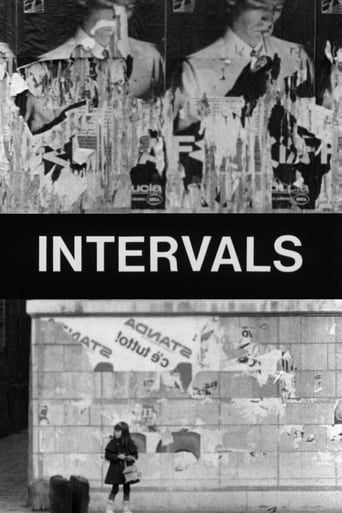

After playing with our expectations, this turns out to be a very different sort of film.
... View MoreClose shines in drama with strong language, adult themes.
... View MoreThrough painfully honest and emotional moments, the movie becomes irresistibly relatable
... View More.Like the great film, it's made with a great deal of visible affection both in front of and behind the camera.
... View More"Intervals" is a 6.5-minute short film from 1969, so a couple more years and it has its 50th anniversary. But is this really a reason to celebrate? It is a British production and the writer and director is Peter Greenaway. He was still in his 20s when he made this film and it's an early production from him, but not one of his earliest. It's also in black-and-white which was not too uncommon for the 1960s. Other than that, my review title summarizes it basically. It is nothing but people walking in front of walls. The narrator that we occasionally hear is Italian for whatever reason. I personally did not see any artistic value in here and I believe that honestly, this is a film that almost everybody with a camera can re-enact or make. I am also not sure how much was staged in here or if it is a 100% documentary film. Anyway, I did not enjoy the watch at all as you have probably understood by now. Not recommended.
... View MoreThis is an example of one of the very earliest films made by avant-garde director Peter Greenaway. As you should fully expect, it's a highly experimental bit of work that is focused on film structure to a pretty specific level of mathematical precision. It takes the form of a series of static shots of Venice in a visual sequence which is repeated three times. Each loop is accompanied with a different soundtrack, beginning with a metronome, then with a voice-over and lastly adding some Vivaldi music. The latter composer was a famous native of Venice and one of its most significant cultural exports, however, the film itself is pretty far removed from being travelogue material. Shot in black and white, it actively avoids capturing anything conventionally pretty and instead records images of the back streets of this city. As a result, the material could have almost come from anywhere, far less one of the most iconic and famously beautiful cities in the world. I'm guessing that subverting expectations is part of what Greenaway is up to here. The film itself is very short, so it's hard getting too excited about its contents. It's essentially an exercise in experimenting with the rhythms of the image and sound of cinema. In other words, it's typically left-of-centre fare from this director once again.
... View MoreA short examination of structure and sound, this film shot in black and white in the location of Venice presents three sections of similar film to us over its duration of six minutes. In the first section a metronome is used to count events in the film. People walk across the frame, sometimes in the foreground, which is accompanied precisely by a different sound. In the second section a male Italian voice can be heard counting through the alphabet. Music by Vivaldi is heard in the third. Shot 26 December 1968 - 8 January 1969. Dubbed 30 October 1973.
... View MoreThe same film footage is played four or five times with a different audio background each time. I liked it personally because it was a good example of how we react to film through both audio and visual cues, and as an example of how rythms can be imposed on anything. There's is also some amusing bits in there too. Not essential greenaway, but worth seeing if you can find it.
... View More